http://www.skyandtelescope.com/howto/basics/How_to_Start_Right_in_Astronomy.html
Good advice from Sky & Telescope
Posted from WordPress for Android via my Samsung smartphone. Please excuse any misspellings. Ciao, Jon
Sunsets, Stars, West, Wind
http://www.skyandtelescope.com/howto/basics/How_to_Start_Right_in_Astronomy.html
Good advice from Sky & Telescope
Posted from WordPress for Android via my Samsung smartphone. Please excuse any misspellings. Ciao, Jon
Bellatrix, Orion’s third brightest star, means Female Warrior | Tonight | EarthSky.
Female Warrior. I like it (for obvious reasons). Female Conqueror is even better, but I’ll settle for Warrior.
Twelve degrees Fahrenheit this morning as I setup the tripod and camera for the third pre-dawn photo shoot of Saturn and Venus. Completely calm, unlike yesterday morning, so no jiggles to the camera, beyond my fumbling numb fingers. I opted for longer exposures (three or four seconds), so I ended up with some trails, especially when using the telephoto lens. Otherwise, much the same as before, with the exception of the planetary dance partners.
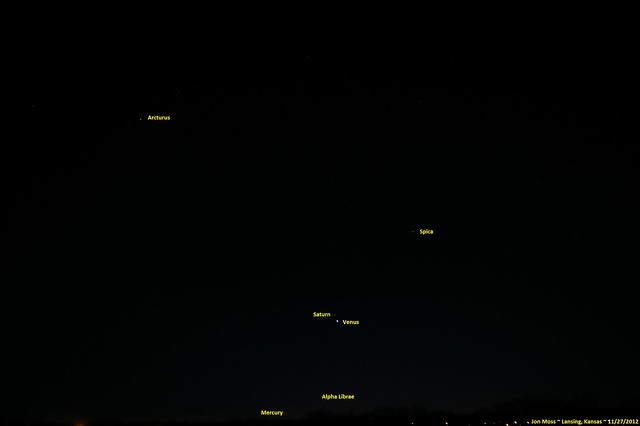
I don’t plan on repeating this for a fourth time tomorrow morning, but I do plan on trying to capture the full moon as it approaches Jupiter tomorrow night. There also happens to be a penumbral lunar eclipse occurring Wednesday evening.
Wednesday, November 28
Full Moon arrives at 9:46 a.m. EST. It appears against the background stars of Taurus the Bull before dawn this morning, approximately midway between the Pleiades and Hyades star clusters and below brilliant Jupiter. (The Moon will slide within 1° of the planet after sunset tonight.) But the Moon has a lot more going for it today. First, it passes through the outer part of Earth’s shadow. This penumbral lunar eclipse will slightly darken the Moon’s northern half. People in much of North America can see the eclipse’s early stages, which begin at 7:15 a.m. EST. (Those in Australia, eastern Asia, and the Pacific islands have the best views of the event.) Second, this Full Moon is the smallest (29.4′ in diameter) of 2012. Our satellite’s relatively diminutive size arises because it reaches the farthest point in its orbit around Earth at 2:37 p.m. EST today, when it lies 252,501 miles (406,362 kilometers) from Earth’s center. (Astronomy.com ‘The Sky This Week – November 23 – December 2, 2012’)
I learned last night at the November general meeting of the Astronomical Society of Kansas City that we have just fifty days (forty-nine as I write this blog) until the end of a Mayan age (the 13th Bak’tun). More commonly known to us as the Winter Solstice on December 21, 2012 (12/21/12 or 21/12/12 depending on your longitude). I had a lot on my mind as I drifted off to sleep last night, but when I woke to clear skies and a newly risen Venus blinking at me through the bare branches of trees along my eastern horizon, I shook off the last vestiges of ancient doom and gloom and braved the brisk late fall pre-dawn environs with my tripod and camera.
Armed with new tips and techniques garnered from Tom Martinez’s astrophotography presentation during the club’s Astro 101 session, I attempted a long exposure (ten seconds long) of the Big Dipper using my normal lens:
I was gratified to discover that my camera can take even longer exposures without the necessity of a handheld remote. Not that I don’t plan to purchase a remote for it soon though.
I didn’t attempt to capture Canis Major or Orion in a long exposure since I would have been shooting west over the well-lit parking lot of City Hall. Instead, I turned my camera towards the southeast and bright shining Venus and the slightly dimmer Saturn.
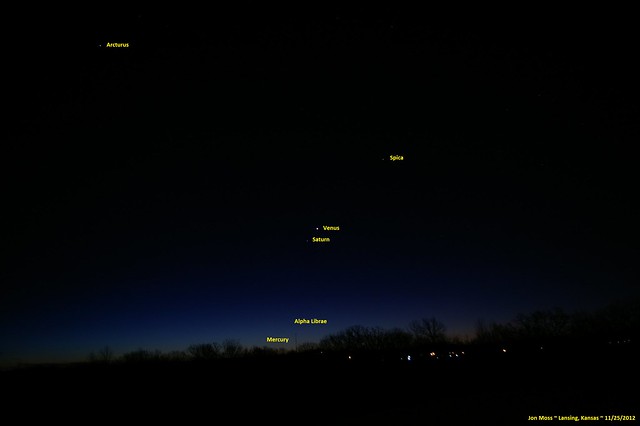
I knew Mercury had risen shortly after six o’clock, but I couldn’t see it clearly until about a quarter after.
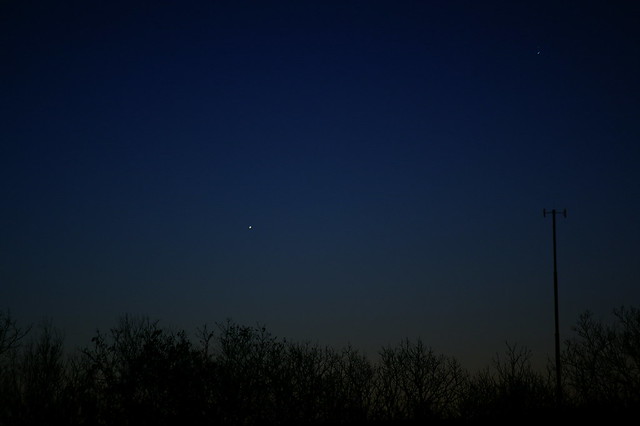
Later, I accidentally captured not only Mercury, but a passing plane, as it took off from KCI (northeast of my location).
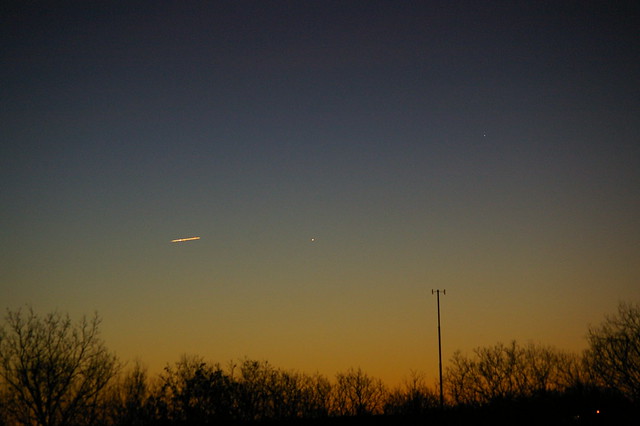
When I got back to my laptop and downloaded the photos, I also double-checked and compared them to the alignment at the time they were taken using the Star Dome Plus java applet at Astronomy.com:
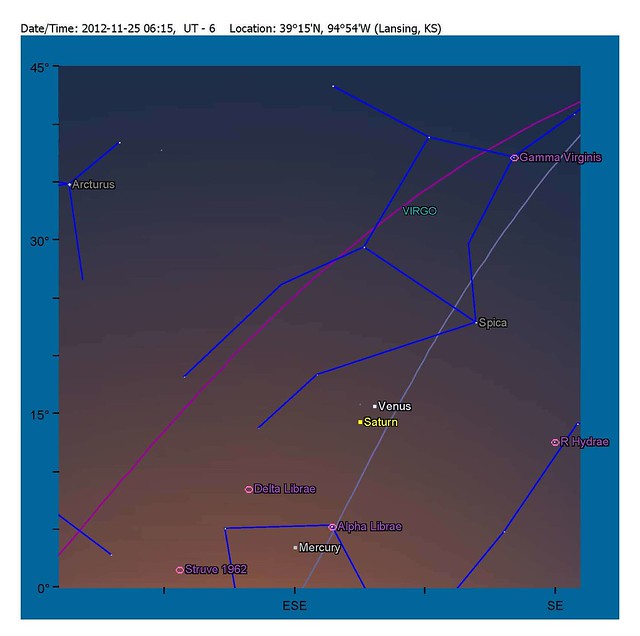 A short successful photo shoot this morning. I didn’t hang around for the sunrise, since I judged it wouldn’t be as pretty as the one I captured Saturday morning.
A short successful photo shoot this morning. I didn’t hang around for the sunrise, since I judged it wouldn’t be as pretty as the one I captured Saturday morning.
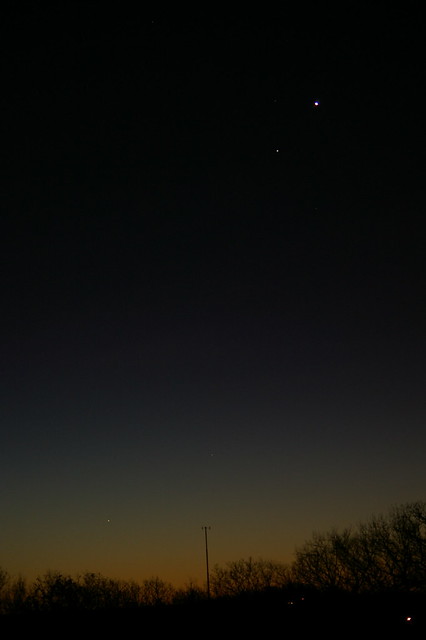
Weather permitting, I’ll be repeating this activity for the next two or three mornings. I’m excited to see Venus and Saturn pass each other in the night (or very early morning).
And next week I’m going to wish I was visiting Egypt to witness a once in 2,737 years event involving these same three planets and the Great Pyramids at Giza.
 I missed the opportunity to count stars over the weekend. Clouds obscured the heavens Friday and Saturday night, but I had absolutely no excuse not to step outside Sunday evening and participate in the Great World Wide Star Count. Thank goodness that Sky & Telescope‘s Facebook feed reminded me with their article ‘A Star Count for Everyone‘ this morning.
I missed the opportunity to count stars over the weekend. Clouds obscured the heavens Friday and Saturday night, but I had absolutely no excuse not to step outside Sunday evening and participate in the Great World Wide Star Count. Thank goodness that Sky & Telescope‘s Facebook feed reminded me with their article ‘A Star Count for Everyone‘ this morning.
I checked my local five day forecast and I should be able to find Cygnus and count stars tonight and Wednesday. Tuesday, Thursday and especially Friday are iffy. This year, I’m going to try to do it from a couple of different locations, not just my backyard (like I did last year).
Here’s all you need to know to participate:
All you’ll need are a clear evening sky sometime between October 5th and 19th, your own two eyes, and a set of simple star charts. First, download the handy five-page activity guide (available in 16 languages) and print the star charts. If you live in the Northern Hemisphere, you’ll be looking high up for the constellation Cygnus, and its Northern Cross asterism. If you’re south of the equator, the target area surrounds the Teapot in Sagittarius. Each of the seven maps shows stars down to a different magnitude limit, plus one for a cloudy sky.
Then, after stepping out under the early-evening sky and letting your eyes adjust to the darkness, match one of the charts to what you see overhead. Step back inside and report what you’ve found online. You’re done! (Unlike many contests, you can enter more than once! You might be surprised by how much the sky’s darkness can vary from night to night.)
A Star Count for Everyone, Sky & Telescope, Oct. 5, 2012
I stepped outside at a quarter past five o’clock to gauge the quality of the skies. Clear, but not as clear as yesterday’s crisp clean views of Venus, Jupiter, Orion and the waning Moon. Not that I complained. I keep the camera and tripod close to the front door so it’s just a matter of a minute or two before I can snap a couple of photos to share.
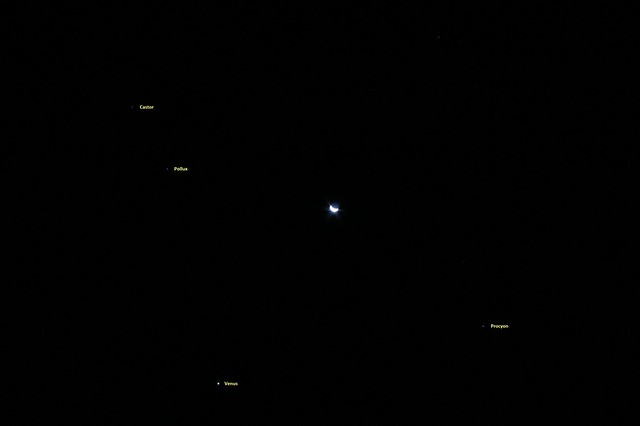
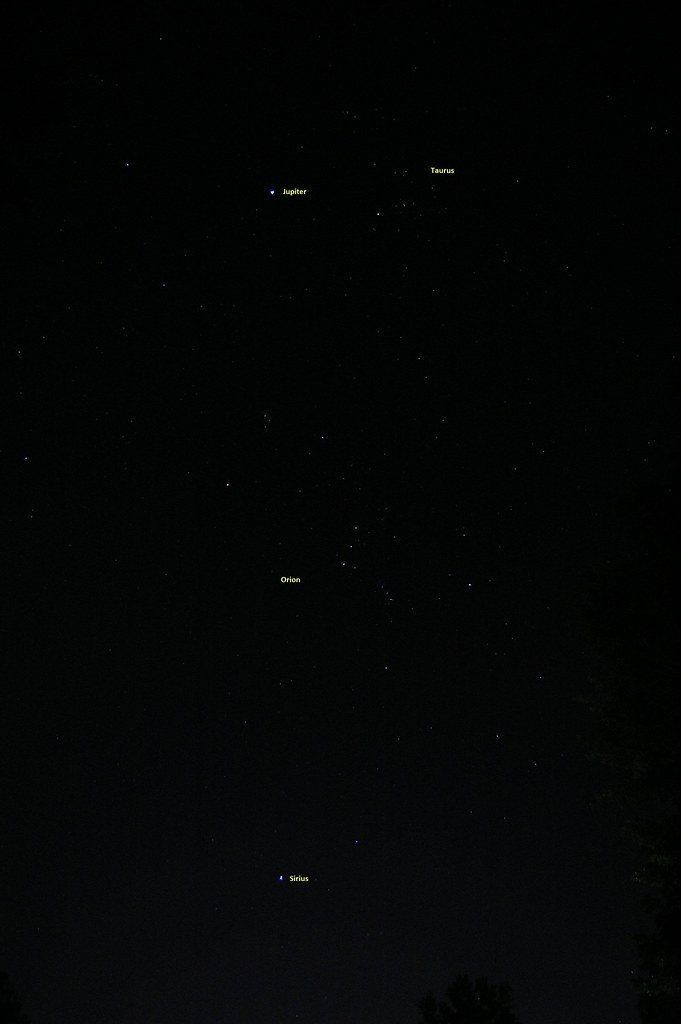
Both of these photos taken between 5:25 and 5:30 a.m. this morning, so here’s a star chart to help you identify the planets, stars and constellations from my location at that time looking east-southeast.
Tomorrow morning, the waning moon catches up to Venus in Cancer and as an extra treat, I plan to search for M44, the Beehive Cluster, found in the chest of that Crab constellation. This open cluster is visible to the naked eye and even more so to binoculars. Perhaps my camera, with the telephoto lens mounted, won’t be too shabby either.
I couldn’t wait for midnight Friday night. The forecast for the weekend seemed unbelievable, especially after the scorching heat of the last month. Clear skies and mid to lower 80s for the high temperatures over the next several days. I came home from work to a grilled steak and baked potato dinner, prepared by Terry. Mmm-mmm good.
After dinner, Terry and I began reviewing the DVR play list and guide, deciding to delete many old recordings to free up some disc space. Our daughter called and chatted with us for about forty-five minutes. The conversation ended abruptly when her phone battery died.
For dessert, Terry blended a frozen raspberry lemonade. I read for a few minutes, while slowly sipping the drink (trying to avoid a brain freeze). I asked him to wake me up around midnight so I could scout the skies in search of the Andromeda galaxy and the planet Neptune. Apollo followed me upstairs to the bedroom to join me in my nap.
Terry woke me up just shortly after midnight. I rubbed the sleep out of my eyes and found my flip flops. I followed Terry back downstairs to the band room and walked out the patio door to the back yard. The skies were clear, if not what you’d call dark (why do my neighbors leave their porch lights on all night long?). I went back inside for one of my star charts and a pair of binoculars. I didn’t trust myself to lug the telescope outside in the dark, not being completely awake yet. A survey with the binoculars should be sufficient for my first attempt.
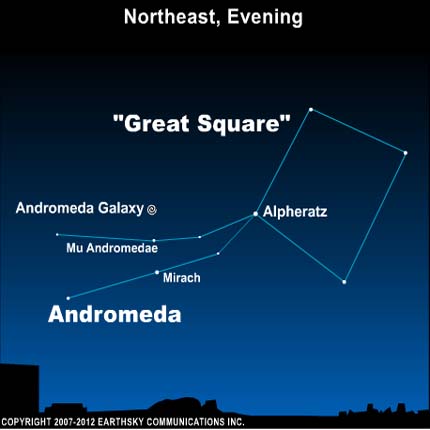 I walked out into my backyard, towards my one remaining pine tree and turned back around to face the east. What a difference a couple of hours makes! I could clearly see the Great Square of Pegasus hovering directly over my roof. In fact, my chimney seemed to be pointing a finger at the famous flying horse. I remembered what I’d read in the EarthSky post about finding the Andromeda galaxy and put what I’d learned to good use. With just a pair of mediocre binoculars, I easily found the smudge that is M31. Now I regretted not moving the XT8 outside before I took my nap.
I walked out into my backyard, towards my one remaining pine tree and turned back around to face the east. What a difference a couple of hours makes! I could clearly see the Great Square of Pegasus hovering directly over my roof. In fact, my chimney seemed to be pointing a finger at the famous flying horse. I remembered what I’d read in the EarthSky post about finding the Andromeda galaxy and put what I’d learned to good use. With just a pair of mediocre binoculars, I easily found the smudge that is M31. Now I regretted not moving the XT8 outside before I took my nap.
I turned ninety degrees to the right and began scanning the southern skies. I can’t see most of the southern horizon, which is blocked by my neighbors tall trees and houses (and all the exterior lighting attached to them). I lose a good twenty if not thirty degrees of sky in all but one direction, to the southwest I can see a bit of horizon, but only through the even worse light pollution generated by the parking lot of a doctor’s office and the streetlights along Main Street (also known as K-7/US-73).
 I needed to find the constellations Aquarius and Capricornus. The ecliptic passes through both of these constellations. Neptune swam the night skies somewhere between the two constellations on the invisible ecliptic course all the planets chart. The trouble in finding Neptune in this area of the sky comes from a lack of bright stars to anchor from for star hopping. I spent the next hour comparing the star atlas from my pocket guide to the stars I saw through the binoculars and eventually convinced myself I had found the southeastern tip of Capricornus. Just above those stars, I believe I found the two brightest stars in Aquarius, Sadalmelik and Sadalsuud, but those two stars were too high above the ecliptic and too far away in the field of view of the binoculars to find Neptune. I needed to do more research and next time use a telescope to help cut through the fog of light pollution.
I needed to find the constellations Aquarius and Capricornus. The ecliptic passes through both of these constellations. Neptune swam the night skies somewhere between the two constellations on the invisible ecliptic course all the planets chart. The trouble in finding Neptune in this area of the sky comes from a lack of bright stars to anchor from for star hopping. I spent the next hour comparing the star atlas from my pocket guide to the stars I saw through the binoculars and eventually convinced myself I had found the southeastern tip of Capricornus. Just above those stars, I believe I found the two brightest stars in Aquarius, Sadalmelik and Sadalsuud, but those two stars were too high above the ecliptic and too far away in the field of view of the binoculars to find Neptune. I needed to do more research and next time use a telescope to help cut through the fog of light pollution.
After an hour, I returned inside and went back to bed, resolved to research better star charts in the morning.
I went back to Astronomy.com and re-read the article on Neptune, but I just couldn’t relate their star chart (shown above) to what I’d observed last night through the binoculars. I would need more magnification and a more steady mount to zoom in and match up the stars shown above to the field of view of the XT8.
 I tried Sky and Telescope’s web page and found a better set of charts in a PDF format in their article about Uranus and Neptune visibility during 2012. I downloaded the document and will print it today to keep with the rest of my star charts.
I tried Sky and Telescope’s web page and found a better set of charts in a PDF format in their article about Uranus and Neptune visibility during 2012. I downloaded the document and will print it today to keep with the rest of my star charts.
Saturdays are always packed full of activities, so I’m hoping I’ll still have the energy tonight to make a second attempt at finding Neptune. My scouting trip showed me what I needed to overcome before I proceed with netting Neptune.
I rode a rollercoaster of challenges this past weekend. On the high side, my son and daughter-in-law drove up from North Texas for a visit. On the down side, despite the worst drought in recorded history, cloud cover prevented me from observing the Perseid meteor shower Saturday night/Sunday morning and the occultation of Venus by the Moon Monday afternoon. The Ides of August dawned clear this morning, the first time in nearly a week I’ve been able to see the morning planets and waning crescent moon shining brightly above the eastern horizon.
I only hit the snooze on my alarm once, because I stayed up too late with Dob and then decided to watch the latest episode of Warehouse 13 instead of going to bed like I should have. My adventures in the backyard with the XT8 and the Intelliscope handheld computer device determined one of the sensors (probably the altitude one) is not reporting to the device as it should. I’ll have to troubleshoot that situation Thursday evening. I attempted to star hop from Deneb to the North American nebula, but seeing (visibility) proved too poor and I need more practice with the XT8 so I know which direction I’m going (what I see in the eyepiece v. what I see in the finderscope v. what I see on my star atlas).
Before the alarm could buzz a second time, I got up, got dressed, grabbed my purse and left the house. I drove the van a couple of blocks up the hill from my house to the dead end in front of City Hall, where I have a completely unobstructed view of the eastern horizon (I routinely see airplanes take off and land at KCI and can usually see the control tower as well). I retrieved the camera and tripod from the back of the van and had it setup, with the normal lens attached, just shortly after 5:30 a.m. I took a few wide field shots to capture all three planets and the moon.
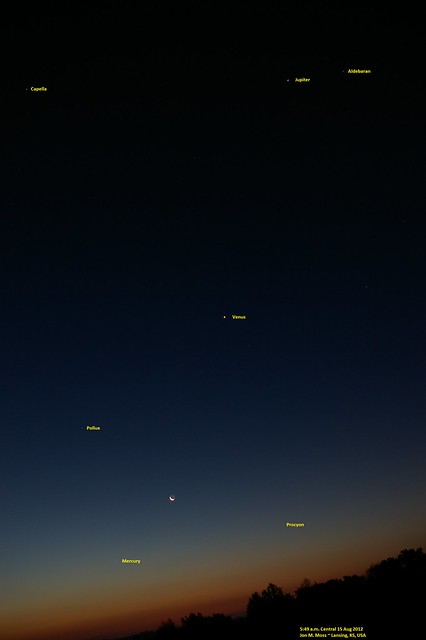
The above photo immediately took me back six months, when I went hunting for Mercury the first time. Last Febriary, I chased after a similar lineup of Jupiter, Venus, the new moon, and Mercury, during the evening hours, looking towards the west. Now, I’m on the flipside, for real. Warm, instead of cold. East, instead of west. Dying moon, instead of newborn moon. Mercury rising, not falling.
I love seeing Orion rising in the east. To me, the Hunter heralds the approaching fall, my absolute favorite season of the year. His two canine pals nipped at his heels (Canis Minor and Canis Major), illustrating we truly are in the ‘Dog Days’ of Summer.
I took a few more shots of all three planets in one frame, then zoomed in on Mercury and the Moon, trying to capture that ellusive earthshine.
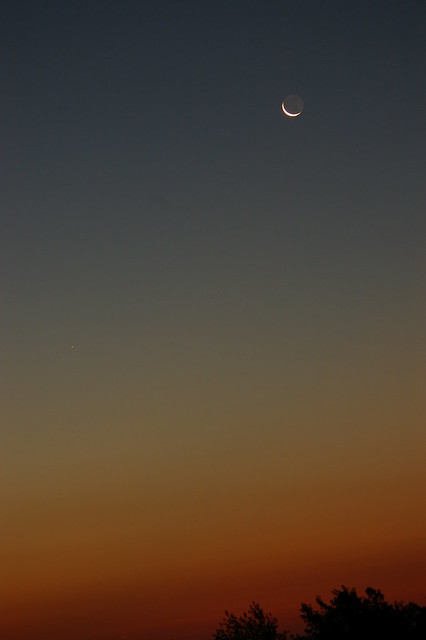
I ended my photo shoot with several closeups of the waning moon, using my telephoto lens. I selected the best of the bunch to upload to Flickr and share here.
Next up for me, astronomically, is hunting for Neptune, which reaches peak brightness (opposition from the sun with us in the middle) on August 24th. I will need to wait until close to midnight Friday to make my first foray, when the other blue planet should be visible from my backyard (between tall trees and houses) in the southern skies, swimming in the constellation Aquarius.
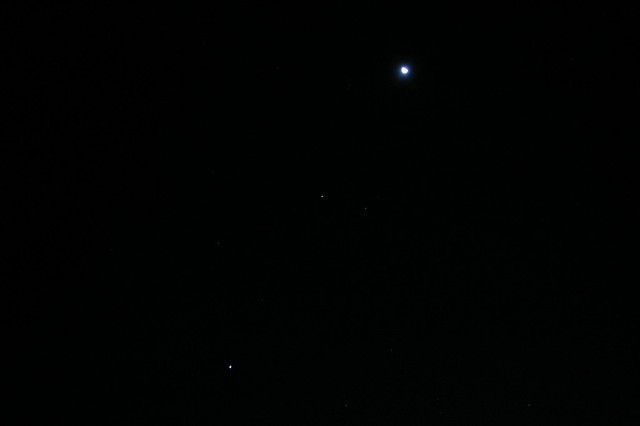
Very early Friday morning, I caught the waning moon approaching Jupiter and Aldebaran. You could draw a line from Venus to Moon and cross over or near Jupiter. The skies were clear and should stay clear throughout the day and into the night, with a forecasted high in the mid-80s, twenty degrees below what we’ve been experiencing for the past several weeks.
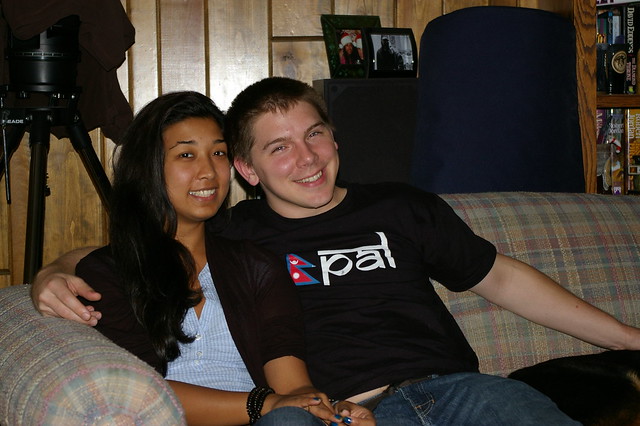 Friday at work was a whirlwind of meetings, including one held off site at another local law firm. I got home a bit early because one of my vanpool riders took the day off, but within fifteen minutes of getting home, my son and daughter-in-law arrived from their all-day road trip from North Texas. We visited with them for an hour and half, when they left to drive into Kansas City to spend the evening with several of their friends who still live in the area.
Friday at work was a whirlwind of meetings, including one held off site at another local law firm. I got home a bit early because one of my vanpool riders took the day off, but within fifteen minutes of getting home, my son and daughter-in-law arrived from their all-day road trip from North Texas. We visited with them for an hour and half, when they left to drive into Kansas City to spend the evening with several of their friends who still live in the area.
Terry cooked an excellent southern comfort food type dinner of chicken-fried minute steaks, organic green beans with turkey bacon, mashed potatoes and home-made white gravy. Too bad the kids didn’t hang around long enough to chow down with us. Terry and I let our food digest a bit, watching the Olympics until the skies darkened enough for some star gazing.
I grabbed the XT8 (affectionately known as ‘Dob’) and carefully carried it out to the lower backyard. This time I took a small table to put my charts on. I set my case of eyepieces on the ground. I brought out the Intelliscope handheld device to attempt an alignment. This device, unlike my ETX-90’s AutoStar, is only used to identify objects, not ‘go to’ them (since the XT8 does not have any motors). The Intelliscope can help you find objects with a warm/cold kind of seeking system. I still haven’t bought a stool to lean against, so my back aches a bit this morning. I did a two star alignment, finding and centering Arcturus first, then Vega.
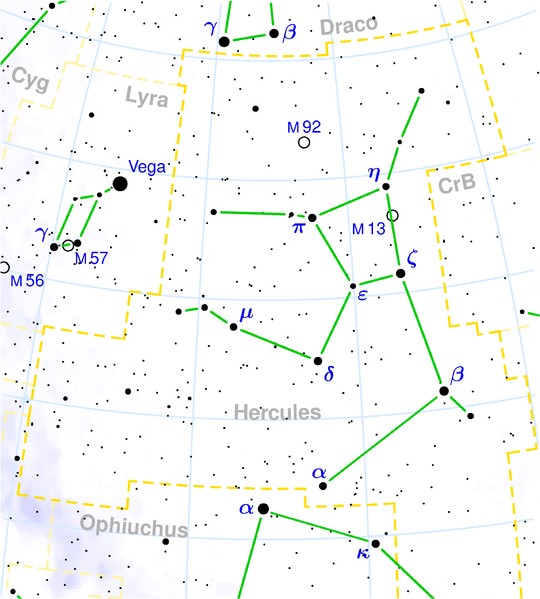 I wanted to revisit the Double Double in Lyra to both confirm that I could find it by star hopping and to attempt to see the double within the double. I asked the Intelliscope to ID what I had centered in the eyepiece and it claimed I’d found the Crab Nebula. Hmmm. That’s in the constellation Taurus, which isn’t visible until early morning hours in the east. I must have done something wrong in the alignment process. I powered off the Intelliscope device and made a note to myself to re-read the manual in the morning. Since I’d already found Vega, I spent several minutes comparing my star atlas to what I was seeing in the finderscope. I found Epsilon Lyrae and observed it with 26mm, 15mm, 9mm and a 2x barlow (using the 26mm and 15mm). Despite the apparent clearness of the skies, I did detect some haziness and thin stratus clouds overhead. That may have inhibited my ability to split the doubles within the doubles.
I wanted to revisit the Double Double in Lyra to both confirm that I could find it by star hopping and to attempt to see the double within the double. I asked the Intelliscope to ID what I had centered in the eyepiece and it claimed I’d found the Crab Nebula. Hmmm. That’s in the constellation Taurus, which isn’t visible until early morning hours in the east. I must have done something wrong in the alignment process. I powered off the Intelliscope device and made a note to myself to re-read the manual in the morning. Since I’d already found Vega, I spent several minutes comparing my star atlas to what I was seeing in the finderscope. I found Epsilon Lyrae and observed it with 26mm, 15mm, 9mm and a 2x barlow (using the 26mm and 15mm). Despite the apparent clearness of the skies, I did detect some haziness and thin stratus clouds overhead. That may have inhibited my ability to split the doubles within the doubles.
 I hopped over to Albireo in Cygnus, just to make sure I could find it again without referring to my star atlas. I used a trick I had read about from some artists who do astronomical sketching where you defocus the stars, especially doubles, to discern their different colors. I did this while observing Albireo and I could clearly see the red and blue for each star in the double. I stretched my back for a few minutes and stared off to the northeast, at Cassiopeia, which I could clearly see as a distinctive ‘W’ shape. I could not see the constellation Perseus, but I did see one or two meteors radiating from the space between Cassiopeia and where Perseus should have been visible (but wasn’t because of the haze and light pollution from the prison just north of my location).
I hopped over to Albireo in Cygnus, just to make sure I could find it again without referring to my star atlas. I used a trick I had read about from some artists who do astronomical sketching where you defocus the stars, especially doubles, to discern their different colors. I did this while observing Albireo and I could clearly see the red and blue for each star in the double. I stretched my back for a few minutes and stared off to the northeast, at Cassiopeia, which I could clearly see as a distinctive ‘W’ shape. I could not see the constellation Perseus, but I did see one or two meteors radiating from the space between Cassiopeia and where Perseus should have been visible (but wasn’t because of the haze and light pollution from the prison just north of my location).
I returned to the scope and began a star hop around Lyra in search of M57, also known as the Ring Nebula. This was a test, for me, not only of my ability to find this fuzzy smoke ring, but also of an 8-inch telescope’s ability to cut through the obstacles inherent at my closest observing site (my backyard). I surprised myself. I found the nebula, quicker than I thought I would, and I even saw it through the finderscope. It probably helped that Lyra was almost straight up above me and the telescope, meaning I had less atmosphere to peer through. Using averted vision, with the 9mm, I could clearly see the ring. I used the background stars to focus, because you can’t really focus well on a smudge that’s fuzzy and faint.
Since I found and saw a nebula with the XT8, I wanted to see if I could find a globular cluster next. And I just happened to know where one was. M13 in the ‘armpit’ of Hercules (see chart above) happened to be overhead, somewhere between Altair and Arcturus. I had some trouble locating the stars that make up Hercules with my naked eye. I took several minutes, stretching my back, to peer overhead, but towards the west, and Arcturus. Eventually, the star dots connected in my mind’s eye and I found the constellation. I oriented the XT8 to the general vicinity where I thought M13 would be. I think I saw it through the finderscope, although I can’t remember specifically. Using the 26mm eyepiece, I centered the globular cluster in my field of view and proceeded to observe this large dense cluster for several minutes with various magnifications.
 I stared off into the northeast again, still trying to find Perseus and also Pegasus. If I could see the Andromeda Galaxy (also known as M31), I would achieve a triple crown of astronomical observing from my backyard with the XT8 (1: nebula; 2: globular cluster; 3: galaxy). I spent nearly a half an hour, roaming around my backyard, changing my point of view and line of sight to the northeast and east. I found Cepheus, but no matter how hard I squinted or averted my eyes, I could not clearly identify the box that makes up the body of Pegasus. Frustrated, and with an aching back, I decided to call it a night at about half past eleven o’clock.
I stared off into the northeast again, still trying to find Perseus and also Pegasus. If I could see the Andromeda Galaxy (also known as M31), I would achieve a triple crown of astronomical observing from my backyard with the XT8 (1: nebula; 2: globular cluster; 3: galaxy). I spent nearly a half an hour, roaming around my backyard, changing my point of view and line of sight to the northeast and east. I found Cepheus, but no matter how hard I squinted or averted my eyes, I could not clearly identify the box that makes up the body of Pegasus. Frustrated, and with an aching back, I decided to call it a night at about half past eleven o’clock.
I returned the telescope to the band room and replaced all the dust caps. I hugged my hubby, for he had brought me a refreshing freshly made strawberry lemonade to enjoy while bending over the telescope for hours. Off to bed and sleep, at least until the dogs started barking when Derek and Royna returned home (sometime after midnight and before five – not exactly sure as I tried to sleep through the commotion).
My alarm only fires off on weekdays, but most days I wake up fifteen minutes early. Not Saturday morning though. When I cleared the sleep from my eyes and checked the clock on my cell phone, it read 5:45 a.m. and I could already tell the eastern horizon was brightening. I grabbed the tripod and camera and went out to the driveway to take a photo of the Moon approaching Jupiter.
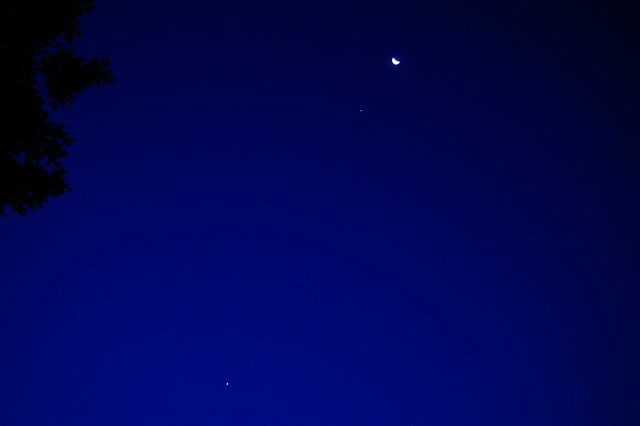
If I happened to live in the Pacific, today I would be able to observe the moon occulting Jupiter. But I won’t be too disappointed, since I can observe the moon occulting Venus next Monday afternoon, between 3:00 and 4:00 p.m. I plan to take a pair of binoculars and my camera equipment with me to work. I will setup on the top of the parking garage and hope I have a clear line-of-sight through the buildings to the west to see the occultation as it occurs.
 But tonight I plan to find a dark sky location and take in as many meteors as I can, raining down from Perseus. I better take a nap this afternoon and set an alarm for one o’clock Sunday morning. Don’t want to miss the best meteor show of the year!
But tonight I plan to find a dark sky location and take in as many meteors as I can, raining down from Perseus. I better take a nap this afternoon and set an alarm for one o’clock Sunday morning. Don’t want to miss the best meteor show of the year!
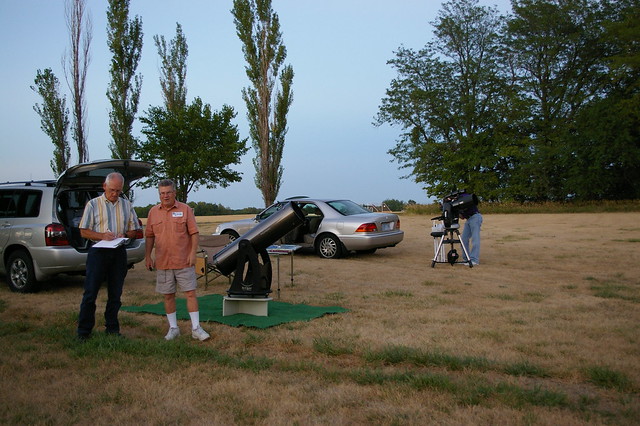
My dad contacted me Thursday to coordinate conveyances for our weekend astronomical adventure, thinking we would be attending the monthly ASKC club meeting, but he was a week early. Since I had mentioned earlier in the week a desire to see the glorious summer spread of our own Milky Way Galaxy, he had called me several times the past few days to see about driving to northern Atchison county to escape the Kansas City area light pollution. Both Wednesday and Thursday evenings turned out to be hazy and cloudy, so we nixed the road trip north.
Instead, I suggested we attend the monthly star party at Powell Observatory. I received two confirmation e-mails from David Hudgins, the club’s star party coordinator extraordinaire. I decided to leave my scope at home because you don’t really need a scope to take in the Milky Way Galaxy. If the skies grew dark enough, it would stretch from the southern horizon, up over the top, clear to the northern one.
I thought perhaps I was reliving last Friday (that would be the 13th) because when I got home early (by ten minutes) I walked into some surreal drama. I won’t go into the stressful week at work (we’ve all had weeks like that), but I looked forward to forgetting work and ignoring the excessive heat by reading books and watching movies in a quiet, air conditioned home with my hubby and two Rotties. I came home to find our satellite on the fritz and Terry needing me to pickup a prescription before the pharmacy closed at seven. While he cooked dinner, I did some preliminary troubleshooting of the satellite system with little success and decided to call DirecTV customer service, knowing I’d probably be on hold for several minutes. The technician wanted us to disconnect, check and reconnect all of our cables, which seemed a ridiculous request since the cable runs are static and have not been touched, moved or manipulated in years. After almost ruining supper in an effort to jump through DirecTV tech support hoops, we hung up on them and sat down to eat.
By now, I had less than an hour to pickup the prescription, so I grabbed my purse and drove to the store. I got as far as the pharmacy counter, where the assistant recognized me and had the prescription ready for me, but when I opened my purse, my billfold was missing. I had left it in the van because I stopped at Starbucks after work for a mocha frappacino treat for the drive home. Now I had to return home for my billfold and repeat the trip back to the pharmacy, a wasted trip, time and gas. When I returned home the third time, Terry had solved the satellite system glich. With our excessive heat and drought conditions, the ground supporting our satellite dish pole has dried up so far down into the ground, that the pole can now be easily moved back and forth and twisted on it’s concrete base. One of our dogs could have bumped into it and messed up the alignment. Terry used the signal strength meter diagnostics channel on the satellite receiver to dial the dish back in.
Hoping that would be the final challenge of the week solved for the moment, I called Dad just after seven o’clock and told him to head my way. I gathered up my camera equipment, my pocket star atlas, a large hardcover edition of Backyard Astronomy (to review Milky Way info), my purse (with billfold) and a lidded glass of cool water. I asked Dad to drive this weekend, volunteering to drive next weekend for the July club meeting. The hour jaunt to Louisburg passed quickly and we arrived at Powell just moments after sunset. The evening cooled off nicely, but remained calm, clear and surprisingly dry. In fact, we experienced no dew (the bane of telescope optics) until after midnight.
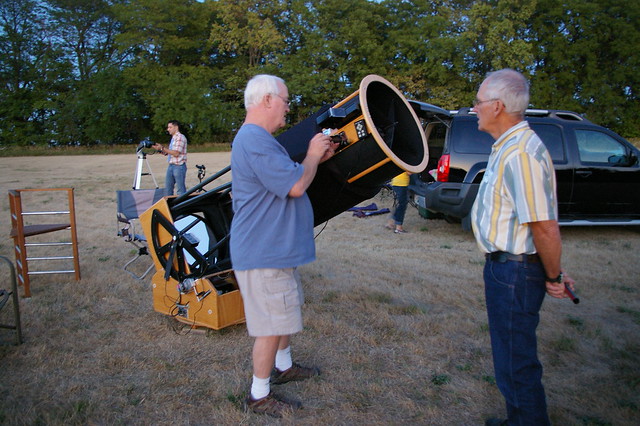
Several club members were already present and setting up their scopes in the East Observing Field (click photo above for photos taken upon our arrival). One member, Mike Sterling, introduced himself to me (asking if I was ‘the’ Jon Moss … apparently my name is known, if not my face or gender, from my blogging). He was in the process of collimating his 20-inch Dobsonian. My dad provided an extra pair of eyes to help finish. Mike also gave us a color brochure published by Astronomy magazine of the illustrated Messier catalog. This will come in handy in the future when I really get serious about an observing award.
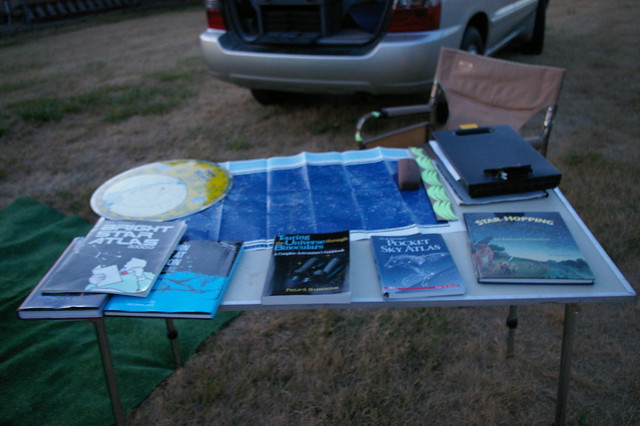
The theme for this month’s star party centered around star charts and atlases. David Hudgins setup a table displaying several popular and easy-to-use books, visual aids and posters. I indicated to David I already owned the Sky & Telescope Pocket Sky Atlas and a smaller version of the wheel night sky star guide (the circular atlas resting on top of the poster in the upper left hand corner of the table shown in the photo above).
Dad and I wondered among the scopes, waiting for twilight to fade and the stars to emerge. Saturn and Mars, along with Spica and Arcturus appeared very early and most of the scopes honed in on our ringed neighbor. By 10:30 pm, the skies had darkened enough to begin hunting for some of the brighter Messier objects. Mike graciously asked me (several times over the course of the evening) what I wanted to observe next. I drew a blank every time because my goal had been to see the Milky Way, not any specific object viewable in a scope. He obligingly filled in the blank by touring through clusters, nebulae and a galaxy found in the constellation Sagittarius, Scorpius, Hercules and Ursa Major. I tweeted the objects as we found them so I would have a record of what we saw and when.
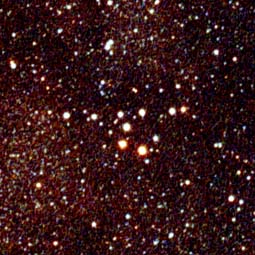
My dad and I also used his binoculars just to see what we could see with them (as opposed to a scope). The highlight of that side project included finding Brocchi’s Cluster (more commonly known by the asterism ‘the Coathanger’). One of the other club members used the Summer Triangle as an aid to locating the Coathanger. As stated in the Wikipedia article: “It is best found by slowly sweeping across the Milky Way along an imaginary line from the bright star Altair toward the even brighter star Vega. About one third of the way toward Vega, the Coathanger should be spotted easily against a darker region of the Milky Way. The asterism is best seen in July-August and north of 20° north latitude it is displayed upside down (as in the picture above) when it is at its highest point.”
* Update * (added after original publication):
I completely spaced out tweeting during the eleven o’clock hour. During this time, Mike disconnected the Goto electronics on his telescope and set me to star hopping for objects near Sagittarius. The first one he tested me with was finding two small globular clusters a small hop away from the gamma star in Sagittarius (the star the delineates the spout of the teapot). If I could find these two clusters, Mike told me I should be able to see both of them at the same time in the eyepiece’s field of view. After about five minutes, I spied a couple of small fuzzy balls, not as distinct as the surrounding background stars, but I thought they might be the clusters. Mike confirmed I had found them by doing a ‘happy dance’ and sing-songing ‘she found them, she found them’ for all to hear. The designations for these clusters are NGC 6522 and 6528.
Mike next set me to finding either M69 or M70 (also hanging out in Sagittarius, but in the bottom of the Teapot). I glanced at his star chart and used his excellent Telrad finderscope (which had a nice large field of view and an easy-to-use red bullseye) to quickly locate one of the Messier objects (probably M69). Again Mike did a happy dance and song.
Mike went looking for another globular cluster, this time between Sagittarius and Scorpius, designated as NGC 6380. I found this one especially interesting because of it’s apparent close proximity to a star.
The third test proved my undoing. Mike moved his scope to Antares in Scorpius and set me to finding M4. I didn’t review his star chart and spent several minutes attempting to find it. Eventually, I gave up and Mike located it.
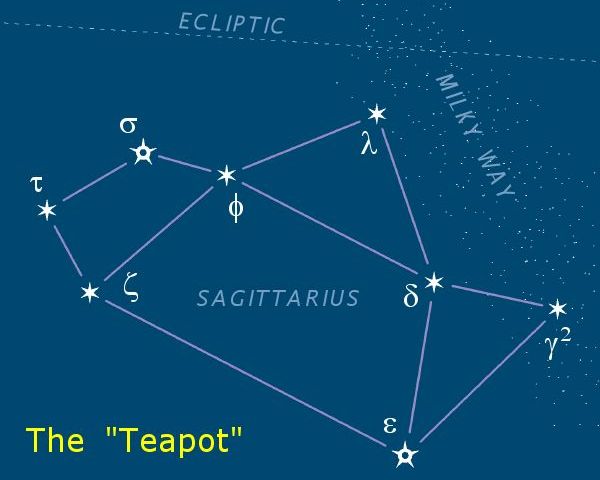
Despite all the mesmerizing Messier distractions, I did succeed in observing the vast sweep of our Milky Way Galaxy. I learned a couple of cool memory aids and bits of trivia about finding the ‘heart’ of the galaxy and the path it takes. Cygnus, the swan constellation, also sometimes known as the ‘Northern Cross,’ flies along the Milky Way, pointing directly to the heart of the galaxy. To find the Milky Way’s heart, locate the Teapot (an asterism for the constellation Sagittarius), visible along the southern horizon during July and August, and imagine steam rising from the spout.
I even attempted to photograph the Milky Way using my simple tripod and DSLR camera, but without an equitorial mount of some kind with a tracking system and the digital photo editing software (to stack multiple repetitive exposures), the best I could accomplish was a three or four second exposure (using ISO 800) and fiddling with the brightness/contrast after downloading:

I also took photos of Cygnus swimming in the Milky Way, the Summer Triangle, the Big Dipper over the dome of the observatory and several of the southern horizon. To see the entire album, click on the photo at the top of this blog.
Soon after 12:30 a.m., Dad and I thanked Mike Sterling for the guided tour of the summer sky. We packed up our gear and drove the hour home, where I finally drifted off to sleep after two o’clock with visions of Messier objects dancing in my head.
Dad and I had a blast and my husband is now having second thoughts about staying home last night. Many thanks to David Hudgins, Mike Sterling and the other members of the Astronomical Society of Kansas City for throwing a fun mid-summer star party.